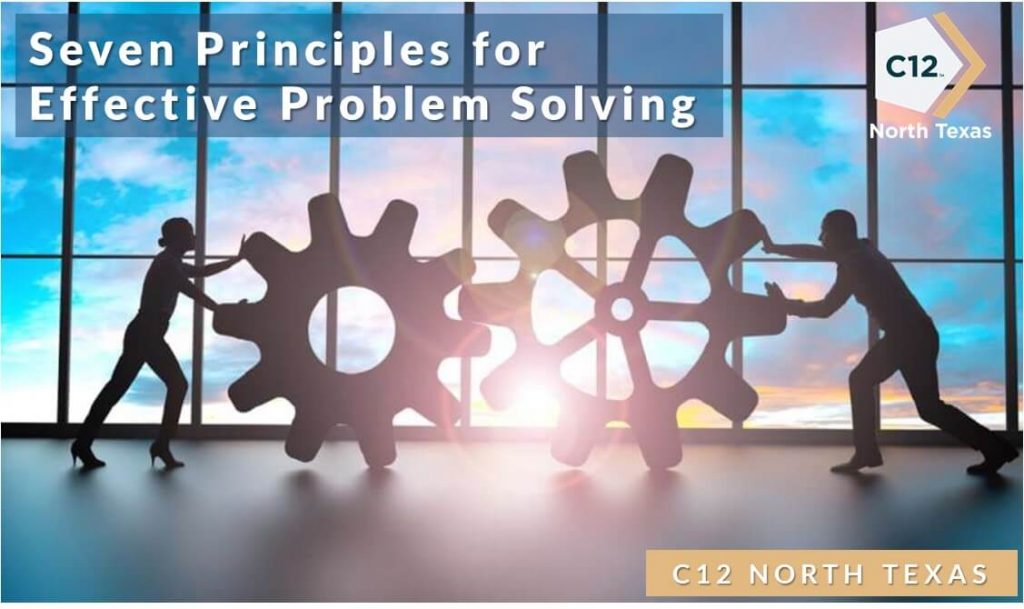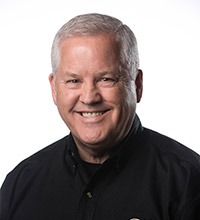Our Promise to
Every Member
We promise to be an example of all we promote, to be accountable to our members and to seek their correction when any deviations appear. We serve as a resource for education, encouragement, challenge, inspiration and accountability.
Seven Principles for Effective Problem Solving

Twenty years ago, I worked in a successful, high tech company and managed a bunch of people developing new products. There were so many challenges. We were trying to master new technologies and techniques to develop these products. We needed new development, quality assurance, documentation, and testing processes. Our distribution models, advertising, product update cycles, pricing, and much more needed adjustments, too. In short, we had a lot of seemingly intractable issues.
We needed help. So, I found and hired a world-famous consultant that I thought could make a difference. I hoped that he could simply tell us the answer to each question. Instead, he gave us a more powerful formula for success. He gave us seven principles for working together better to solve problems that were the key then and a key now to success. Here they are.
1. “It’s always a people problem.”
When I explained all our challenges, he told me something profound. Simply put, no matter the sphere or category, “it is always a people problem.” He meant that a technology problem, for instance, was rarely about technology. It really dealt with the problem-solving abilities of people. Finding a technology solution while ignoring the people was a shortsighted, often ineffectual approach. On the other hand, accurately diagnosing the things that inhibit effective problem solving (e.g., poorly resolved conflict, lack of goal alignment, poorly understood roles) and removing them, freed the people to overcome most any challenge.
2. “They are doing the best that they can do.”
If everything is a people issue, then the next most important element is the story about the other people that we believe. It is quite easy in these relationships to create a story that assigns little credit or virtue to the other person. It is more common to assign them bad intentions (compared to our good intentions) and then we act accordingly. However, my consultant told me to start with a different assumption. Assume that the other person is doing the best that they can in the current circumstances. Put another way, assume positive intent. Immediately this stimulates a more positive attitude toward and receptiveness to the other person. That lays the groundwork for having a healthy discussion and relationship and leads to problem-solving instead of hostility.
3. “Take responsibility for your own response.”
Conflict often produces negative emotions of anger, defensiveness, and distrust. The problem is that these emotions tend to be amplified and reflected by the other person. In turn, this leads us to stake a position and defend it against attacks. Many times, we say, “it is not my fault that they made me feel that way.” In truth, our response is a choice that we make. To believe otherwise is to become a powerless accomplice to an unhealthy situation. Owning our response, however, means that while acknowledging our emotions we can be thoughtful, kind, and effective in how we respond. That leads to effective problem-solving and restored relationships.
4. “Prioritize effectiveness over winning an argument.”
My training and work experience places a high value on knowing things. To be wrong or ignorant was equally bad. Clearly, there is no virtue in mistakes but there are traps to avoid when applying the perfectionist mindset to people. A perfectionist does not concede when the right answer is obvious to them. Disagreements become a matter of the highest principle and worthy of a vigorous defense. However, the reality is that problem-solving with people is rarely so black-and-white. The club of perfectionism can easily damage another person and though there may be a suggestion of a mutual solution, it is often an illusion. My consultant taught effectiveness over winning. “Effectiveness” does not ignore important facts but does emphasize the value of the relationship. It also recognizes that few things in life are above a healthy compromise or better than a jointly owned solution.
5. “Recognize the value of aligned relationships.”
Which leads to the payoff realization. An organization works best when a group of people works together well in a sustained pursuit of a common higher goal. It is magic to witness this or, better, to be involved in such an organization. They typically solve more problems, aspire to greater visions, nurtured better relationships, satisfy more customers, and get better results. The aligned relationships become the engine for the long-term success that far exceeds point solutions to specific problems. This recognition gives a better context to near-term problem solving because it begs the question of what is healthy instead of what is “right.”
6. “Jiggle, don’t fix.”
This is one of my favorite lessons from my consultant. He told me that few people and few situations call for me to inject or prescribe a detailed solution for someone else. When I tried to do that, the other person usually seemed closed to my suggestions. Or maybe they heard me but did not accept ownership of the solution. My friend gave me the idea to simply “jiggle” them. Jiggling means to redirect through sincere questions or alternative perspectives so that the other person can think in a new way. It frees them, allows them to retain ownership of the solution, and honors their own abilities. For the “jiggler,” it helps them to be humble, kind, and respectful instead of a “know it all.”
7. “Practice the Rule of 3’s.”
Finally, my friend taught me the “rule of 3’s.” This rule is especially important for people like me who think of themselves as intuitive or insightful about other people. When I think I know why someone is doing what they are doing, I immediately decide the best response. Occasionally, the initial intuition is dead-on. However, far too often my initial guess about the other person’s motivation has been exactly wrong and because I chose the wrong explanation, my actions have been correspondingly ineffective. The rule is to pause before I act and imagine three possible reasons or causes that led to the other person’s behavior. That causes me to wonder which of the three is correct and that almost always leads to a curiosity that can only be assuaged by asking questions. Now, unfounded certainly is replaced by sincere humility and openness.
My consultant friend changed my approach to people. These seven tools reframed my interactions and refined my spirit about others. They became the foundation for coaching friends and clients to become effective problem-solvers, too. Would these tools be helpful to you?

Tom Hawes is the Principal Chair for C12 North Texas. Since 2011, Tom has had the pleasure of facilitating forums in North Texas. Contact him at [email protected] or 214-620-9366.
Recent Blog
Archives
2020
-
September (1)
-
August (3)
-
July (1)
-
March (4)

